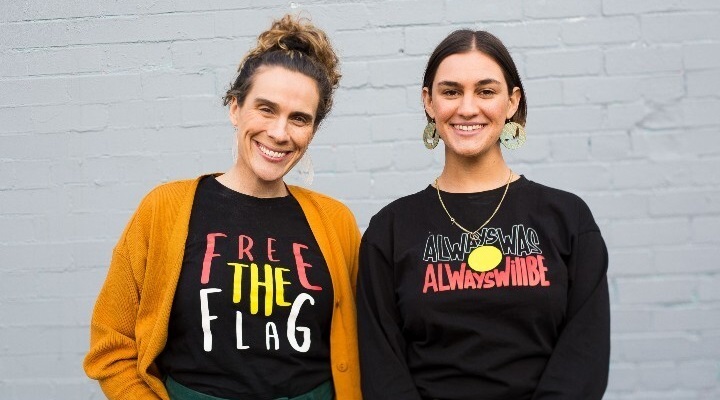When Clothing the Gaps co-founder Laura Thompson heard the news last week that the Australian government had purchased the copyright for the Aboriginal flag and would make it free for all Australians to use, she popped a bottle of champagne. “My phone was ringing like crazy,” Thompson told Inside Retail. “The excitement about the flag being freed was shared amongst not just my staff and close friends, but so many other people.” Thompson, a Gunditjmara woman, had good reason to celebrate.
brate. It was her reaction to receiving a cease-and-desist letter from WAM Clothing, the company that previously held the exclusive rights to the Aboriginal flag, for unauthorised use of the design on Clothing the Gaps’ garments in 2019 that paved the way for the recent change in ownership.
“I started to dig deeper into the background of WAM, and I found out they’re not even an Indigenous company and they’ve also been implicated in importing fake Aboriginal art. It just kicked off that [frustration] that they were the only people we could pay for permission to use the flag,” she recalled.
The very same day that she received the cease-and-desist letter, Thompson started a petition to ‘free the flag’. It went on to get 165,000 signatures, was backed by AFL clubs around the country, led to a 2020 senate inquiry into the copyright and licensing arrangements for the Aboriginal flag and ultimately, resulted in the government’s acquisition of the copyright for $20 million.
“It was really humbling to hear [Federal Minister for Indigenous Australians] Ken Wyatt say recently that he couldn’t ignore the amount of people – and he made a point to say non-Indigenous people – that wrote to him about the Free the Flag campaign,” she said.
Who gets to use the flag
Finally, after more than two years of boycotting the flag on its garments and campaigning for a change, Clothing the Gaps is free to incorporate the design without seeking permission from anyone. But now, so is every other brand and business in Australia, including those not owned or led by Indigenous people. For some, this is hardly an improvement over the previous state of affairs.
Dr Bronwyn Carlson, head of the department of Indigenous Studies at Macquarie University, believes the flag should only ever be used by Indigenous people or Indigenous-owned businesses.
“The government, if genuine in its actions, could have bought the copyright and gifted it to all Aboriginal and Torres Strait Islander peoples and communities. [Prime Minister Scott Morrison] instead gave the copyright to the government and allowed all Australians to use it,” Carlson told Inside Retail.
She argues that the flag is a symbol of Aboriginal people’s unceded sovereignty of their lands, and believes it’s inappropriate for the copyright to now be owned by the Australian government.
“We have already seen examples of non-Indigenous people and organisations seeking to use the flag in commercial and other ventures,” Carlson said.
But while Thompson acknowledged this possibility, she thinks it can mostly be solved through awareness-building.
“Some people are worried that [the flag] could be exploited and that lots of non-Indigenous people are going to start making flag products,” she said.
“We’ve already started a conversation on our platform to make sure that when we’re buying Aboriginal flag products, we are buying them from Black businesses. It’s just an educational piece.”
She also points out that Harold Thomas, the Luritja artist who designed the flag in 1970, supports the new arrangement.
In one of the few interviews he has given on the subject, Thomas told Seven News, “The Aboriginal flag is in a safe place, where the Commonwealth will protect and be the custodian of it. I like that, and my family likes that, and my tribal family thinks it’s a great idea because then it’s freed up to be accessed for all sorts of people – all Australian people mind you, not just Aboriginal. It allows the Aboriginal flag to breathe a new life in itself. It becomes in partnership with the Australian flag, and that I love.”
What to know before you use the flag
We asked Joel Barrett, a partner in Allens’ intellectual property and patent and trademark practice, what the change in copyright ownership means for businesses. Here is his advice:
“Generally speaking, this means that Australian businesses can now use the Aboriginal flag for commercial and non-commercial purposes, without needing to get permission or pay licence fees. The Prime Minister has provided a few examples of permitted use, including printing the flag on sports apparel, using it on websites and incorporating it into artworks. However, businesses should be aware of some important exceptions, including that they are not allowed to manufacture Aboriginal flags or bunting (as the government has granted Carroll & Richardson Flagworld exclusive rights in relation to commercial production), they will need to respect Harold Thomas’ moral rights, and they will need to comply with any laws and restrictions that the government may impose in the future.
“It is likely that the government will publish protocols for using the Aboriginal flag with respect and dignity, similar to the ones that are in place for the Australian national flag. It is also important to keep in mind that Harold Thomas retains his moral rights in the Aboriginal flag, including the right to be attributed as the artist, the right not to have somebody else falsely attributed as the artist, and the right not to have the Aboriginal flag subjected to treatment that is prejudicial to Mr Thomas’ honour or reputation.
“Uses that might breach Government protocols or Mr Thomas’ moral rights include distorting, obscuring or altering parts of the Aboriginal Flag, changing its colours or dimensions, using it in derogatory or controversial contexts, and using it without crediting Mr Thomas as the artist.”

